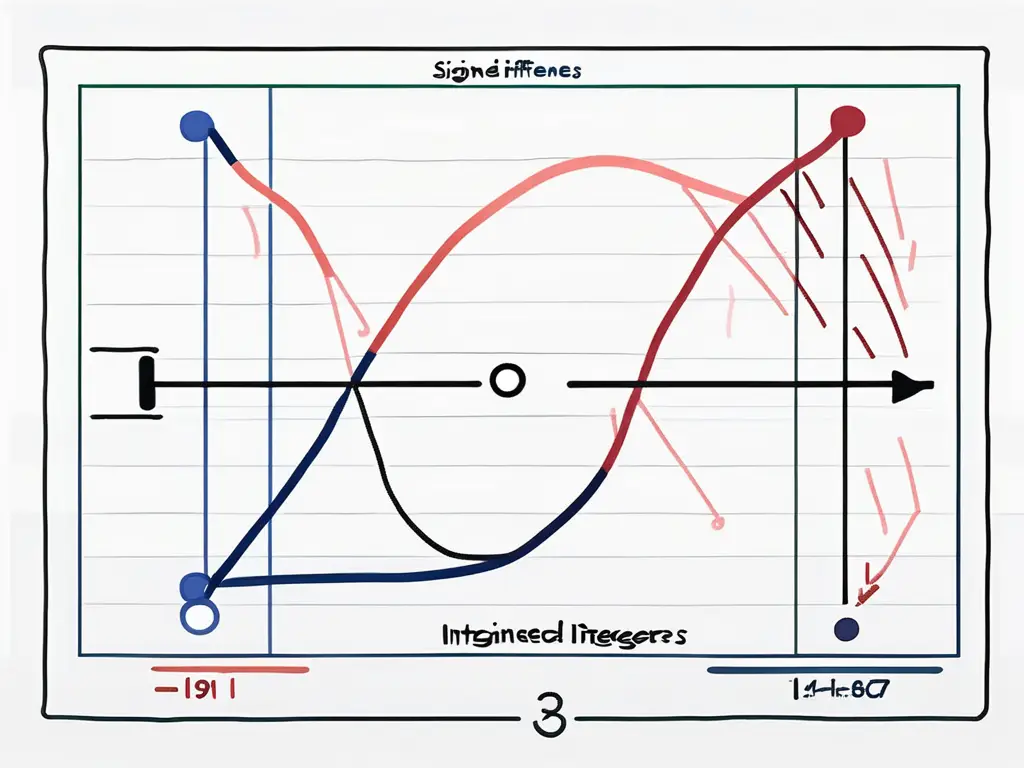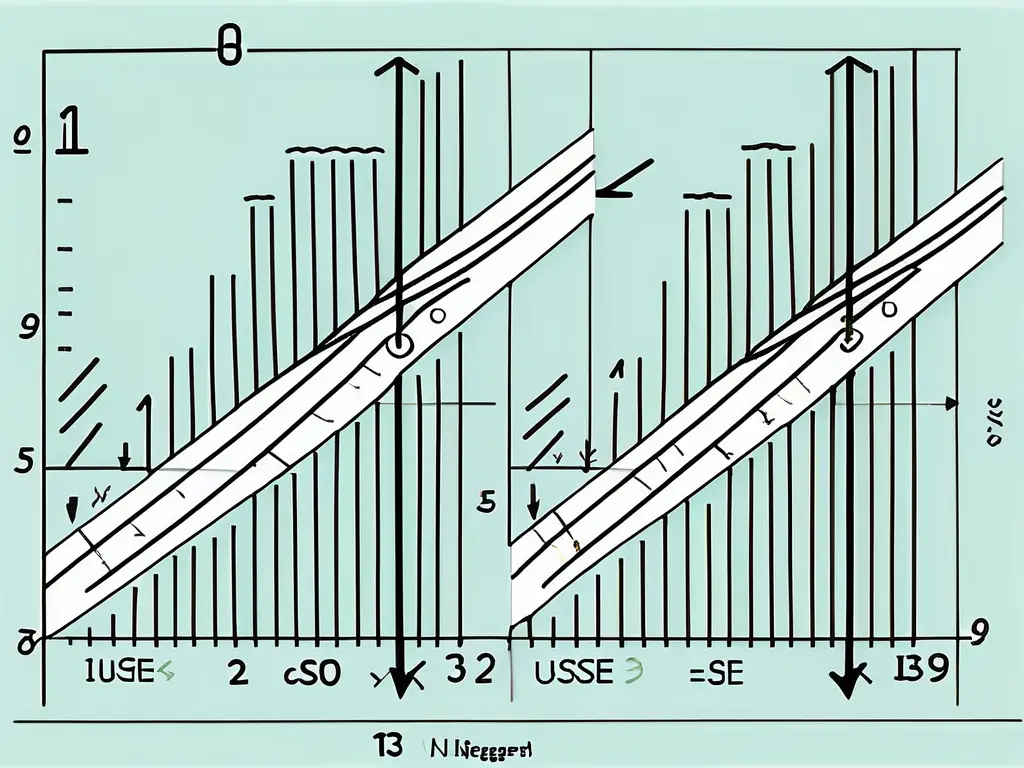When working with numbers in programming, one important concept to understand is the difference between unsigned and signed integers. While they may sound similar, some key distinctions can impact how you store and manipulate numerical data. This article will explore the definitions, mathematical principles, practical applications, and common misconceptions surrounding unsigned and signed integers. By the end, you’ll have a solid understanding of these integer types and be able to make informed decisions when working with numerical data in your programs.
Defining Unsigned and Signed Integers
Before diving into the differences between unsigned and signed integers, let’s first ensure we’re on the same page about what they are.
Understanding the differences between unsigned and signed integers is crucial to computer programming. These data types are fundamental in storing and manipulating numbers in a computer’s memory.
What is an Unsigned Integer?
An unsigned integer is a data type that can represent only non-negative numbers. This means that it can hold values from 0 to a maximum value, which is determined by the number of bits it has. For example, an 8-bit unsigned integer can hold values from 0 to 255.
Unsigned integers are often used when dealing with quantities that cannot be negative, such as the number of elements in an array or the pixel intensity in an image. By restricting the range to non-negative values, unsigned integers efficiently utilize the available memory space.
What is a Signed Integer?
In contrast, a signed integer can represent both positive and negative numbers. It uses one of the bits to represent the sign of the number, with 0 indicating a positive value and 1 indicating a negative value. The remaining bits represent the magnitude of the number. This allows signed integers to hold values from a negative minimum to a positive maximum. For example, an 8-bit signed integer can hold values from -128 to 127.
Signed integers are commonly used when the represented data has positive and negative values, such as temperature readings or financial transactions. By incorporating a sign bit, signed integers can handle a wider range of numerical values within a fixed number of bits.
The Mathematical Principles Behind Unsigned and Signed Integers
Now that we understand the basic definitions of unsigned and signed integers, let’s explore the mathematical principles behind them.

Unsigned integers are whole numbers that are always non-negative, meaning they do not include a sign to indicate positivity or negativity. They are represented in binary format, where each bit holds a value of either 0 or 1. The binary representation of unsigned integers directly corresponds to the value of the number, making them straightforward for computers to process in arithmetic operations.
Signed integers, on the other hand, include both positive and negative whole numbers. In binary form, the most significant bit is used to indicate the sign of the number. This means that signed integers have a wider range of values they can represent compared to unsigned integers, but they require additional processing to handle negative numbers.
The Role of Binary in Unsigned and Signed Integers
Both unsigned and signed integers are represented in binary format, with each bit having a value of either 0 or 1. This binary representation allows computers to perform arithmetic operations on the numbers efficiently. For unsigned integers, the binary representation directly corresponds to the value of the number. However, for signed integers, the most significant bit is used to indicate the sign of the number.
Understanding the binary representation of integers is crucial for computer systems to manipulate and store numerical data effectively. By leveraging the binary system, the foundation of all digital systems, computers can execute complex calculations quickly and accurately.
How Negative Numbers are Represented in Signed Integers
Representing negative numbers in signed integers involves using two’s complement. In two’s complement, the positive representation of a number is inverted (changing 0s to 1s and vice versa) and then one is added to the result. This allows signed integers to easily represent negative numbers without needing a separate sign bit.
Two’s complement is a clever method of simplifying arithmetic operations involving negative numbers in computers. By utilizing this technique, programmers can seamlessly perform addition, subtraction, and other mathematical operations on signed integers, ensuring accurate results across various computational tasks.
Differences Between Unsigned and Signed Integers
Now that we’ve explored the underlying mathematical principles let’s highlight some key differences between unsigned and signed integers.

Range of Values
One major difference between unsigned and signed integers is the range of values they can represent. Unsigned integers only represent non-negative values, so their range starts from 0 and goes up to the maximum value they can hold. On the other hand, signed integers can represent both positive and negative values, so their range goes from a negative minimum to a positive maximum.
For example, an 8-bit unsigned integer can represent values from 0 to 255, while an 8-bit signed integer can represent values from -128 to 127. This difference in range is important to consider when choosing the appropriate data type for your application.
Memory Usage
Another important distinction is the memory usage of unsigned and signed integers. Since they can only hold non-negative values, unsigned integers don’t need to allocate a bit to represent the sign. This means that unsigned integers can utilize all of their bits to store the number’s magnitude, allowing them to represent larger values than signed integers with the same number of bits.
For example, a 32-bit unsigned integer can represent values from 0 to 4,294,967,295, while a 32-bit signed integer can represent values from -2,147,483,648 to 2,147,483,647. This difference in memory usage can be crucial when working with large numbers or optimizing memory consumption in resource-constrained systems.
Arithmetic Operations
There are some differences between unsigned and signed integers regarding arithmetic operations. Unsigned integers perform arithmetic operations using modular arithmetic, meaning that if an operation’s result exceeds the maximum value, it wraps around to 0. On the other hand, signed integers handle arithmetic operations differently. Overflow and underflow can lead to unexpected results if you’re not careful.
For example, if you add 1 to the maximum value of an unsigned integer, it will wrap around to 0. However, adding 1 to the maximum value of a signed integer will result in a numeric overflow, which can lead to undefined behavior. It’s important to be aware of these differences and handle arithmetic operations accordingly to avoid potential bugs or errors in your code.
Understanding the differences between unsigned and signed integers is essential for writing robust and efficient code. By considering the range of values, memory usage, and the behavior of arithmetic operations, you can make informed decisions when choosing the appropriate data type for your specific application requirements.
Practical Applications of Unsigned and Signed Integers

Understanding the nuances of unsigned and signed integers is crucial in programming, as it can significantly impact the behavior and efficiency of your code. By choosing the appropriate integer type for different scenarios, you can optimize memory usage and ensure the correctness of your calculations.
Use of Unsigned Integers in Programming
Unsigned integers are commonly used when you need to represent quantities that can only be positive, such as the length of an array or the number of iterations in a loop. By using unsigned integers, you can ensure that these quantities are always non-negative and avoid any confusion.
Unsigned integers are particularly beneficial in bitwise operations and scenarios where arithmetic overflow is a concern. Their ability to represent larger positive values compared to signed integers makes them indispensable in tasks like bitmasking and handling memory addresses.
Use of Signed Integers in Programming
Signed integers are useful when you need to represent positive and negative numbers or perform subtraction calculations. They allow you to handle a wider range of numerical values and provide flexibility in various programming scenarios.
Additionally, signed integers play a crucial role in scenarios where zero is significant or when you need to differentiate between positive, negative, and zero values. Their ability to represent negative numbers makes them essential in applications like financial calculations, temperature conversions, and algorithm error handling.
Choosing Between Unsigned and Signed Integers
Now that you understand the differences and applications of unsigned and signed integers, you may be wondering how to choose between them in your own programs. Here are some factors to consider:
Factors to Consider
When deciding which type to use, consider the nature of the values you need to represent and the operations you’ll be performing on them. If you’re working with always non-negative quantities, such as array sizes, unsigned integers may be a suitable choice. On the other hand, if you’re dealing with numbers that can be both positive and negative, signed integers may be more appropriate.
It’s essential to think about the potential for overflow in your calculations. Unsigned integers can hold larger positive values than their signed counterparts but are more prone to overflow issues when subtracting or comparing values. On the other hand, signed integers handle negative values naturally and can help prevent unexpected behaviors due to overflow.
Impact on Program Performance
Another consideration is the impact on program performance. The choice between unsigned and signed integers can affect memory usage, especially when dealing with large arrays or datasets. It’s important to analyze your program’s requirements and choose the integer type that balances memory efficiency and functional correctness.
The choice between signed and unsigned integers can also impact your program’s execution speed. In some cases, operations involving unsigned integers can be faster because they don’t need to perform sign extension. However, signed integers are often more versatile in arithmetic operations, which can lead to more efficient code in certain scenarios.
Common Misconceptions and Pitfalls
When working with unsigned and signed integers, you should be aware of some common misunderstandings and pitfalls.
Understanding the differences between signed and unsigned integers is crucial in programming. Signed integers can represent positive and negative numbers, while unsigned integers can only represent non-negative numbers. This distinction is important when choosing the appropriate data type for your variables, as attempting to store negative values in unsigned integers can lead to unexpected behavior.
Misunderstanding of Negative Values in Unsigned Integers
One common misconception is attempting to store negative values in unsigned integers. Since unsigned integers can only hold non-negative values, any attempt to store a negative value will result in unexpected behavior. It’s important to use signed integers when working with negative numbers.
When working with signed integers, handling negative values properly is essential to avoid calculation errors. Understanding how two’s complement representation works can help you grasp the concept of negative numbers in binary form, ensuring accurate results in your programs.
Overflow and Underflow Issues
Another common pitfall is forgetting to account for overflow and underflow when working with signed integers. When performing arithmetic operations on signed integers, checking for potential overflow and underflow conditions is crucial to avoid erroneous results. Be mindful of the maximum and minimum values that can be represented by the integer type you’re using.
Overflow can occur when the result of an arithmetic operation exceeds the maximum value that can be stored in the data type, leading to unexpected outcomes. Similarly, underflow happens when the result falls below the minimum representable value, causing inaccuracies in your calculations. By implementing proper error-checking mechanisms, you can ensure the integrity of your numerical computations and prevent these common pitfalls from affecting your programs.
Conclusion
Unsigned and signed integers are fundamental data types in programming that allow you to work with numerical data efficiently. You can confidently use these integer types in your programs by understanding their differences, mathematical principles, practical applications, and potential pitfalls. Remember to choose the appropriate type based on the nature of your data and the operations you’ll be performing. With this knowledge, you’ll be well-equipped to handle numerical data precisely and accurately.
As you delve into the intricacies of unsigned and signed integers in programming, it’s crucial to recognize the parallel importance of robust cybersecurity in safeguarding your digital endeavors. Blue Goat Cyber, with its veteran-owned expertise and comprehensive B2B cybersecurity services, stands ready to protect your operations from ever-evolving cyber threats. Whether you’re dealing with critical medical device security, stringent compliance requirements, or the need for meticulous penetration testing, our team is equipped to enhance your digital resilience. Don’t let cyber vulnerabilities undermine your programming efforts. Contact us today for cybersecurity help and partner with Blue Goat Cyber to turn potential digital risks into fortified assets.


